
15 minute read
RETURNING TO SEMINARY
Returning to Seminary Catholic Telegraph Intern Reflects on Unique Year
BY CHRISTOPHER BUSCHUR
Advertisement
Last semester began normally for seminarians with the usual routine of communal prayer, classes and social obligations. Even after spring break in March, life seemed normal. However, as the reality of pandemic began to set in, life evolved on a seemingly daily basis. I don’t think the reality of the situation truly hit us until our rector announced at our evening Holy Hour that we would be going home for the rest of the semester. Stunned, we tried to enjoy our last few days together as a community. It was a surreal atmosphere, to say the least.
Dispersing to our various homes and parishes, we had to finish out the spring semester of seminary… without seminary. This was certainly not an easy transition. We went through the struggle of conducting classes via video chat, but the greatest hardship was the loss of communal prayer life and, especially, the daily celebration of Mass. I felt disappointed for my brother seminarians who were preparing to be ordained to the diaconate and the priesthood. What is usually a joyful time of year, filled with hope and expectation, turned instead to a time of uncertainty and trepidation. Please remember our new priests in your prayers as they begin their ministry in these tumultuous times.
Before the pandemic set in, I had the opportunity to accept a summer internship at The Catholic Telegraph. I was thrilled to have this new experience and the opportunity to put my undergraduate degree in Communications to good use. Thankfully, despite the capriciousness of the present crisis, I was able to begin my internship as planned. My time with The Catholic Telegraph has given me a behind-the-scenes look at the complex process of publishing a magazine, and it has been a fascinating experience to be involved in the steps from conception to final publication. While the atmosphere at The Telegraph has been far from normal during this time of pandemic, it has been a productive and fulfilling summer. I feel thankful for this opportunity, even under the circumstances.
How will the fall look? I don’t think anyone knows at this point. I expect to be physically back at the seminary this August for classes, but nothing is for certain. In this time, I think it is important to reflect on the virtue of hope. While hope is often the most underrated of the theological virtues, it should permeate every aspect of our lives as Christians. Hope is not a fleeting emotion or feeling, but a firm disposition which rests on our faith in Christ and His love for us. Hope orders us to the Kingdom of Heaven, while also giving us perseverance for the trials of this life. Therefore, during the trials and uncertainty of COVID-19, we should put our hope in Christ, for as the world is turning, Christ is the only constant.
This time of pandemic should remind people of the importance of the Mass and the sacraments. It was easy for me to take Mass for granted when it was just a short walk to the seminary chapel, but my perspective shifted dramatically after the lockdown. We had to endure an involuntary fast from the Eucharist, the source and summit of our faith. Let us use this time to reflect on God’s great gift of the Mass and the sacraments, especially the Eucharist, and to never take these gifts for granted.
Finally, as we continue to weather the storm, may we turn to our Blessed Mother, that we always have hope in her Son, and ever more strive to conform our life to Him, even in the most difficult and unsettling of times.
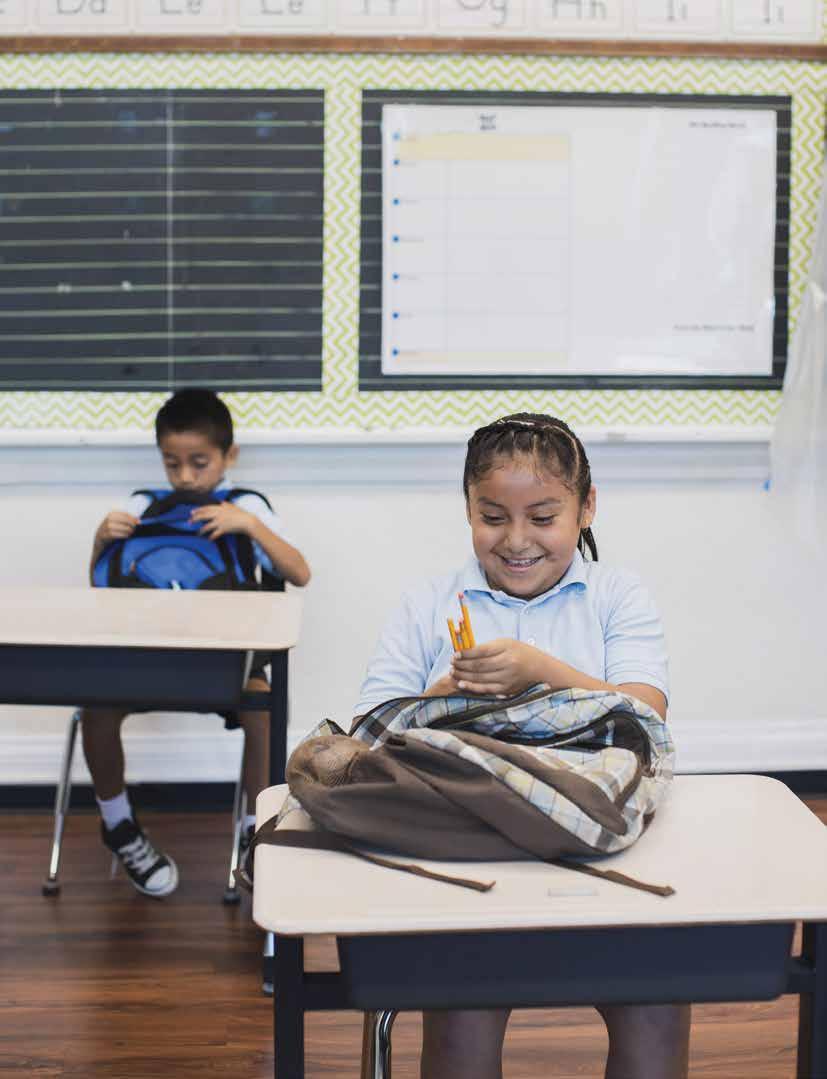
Back to School
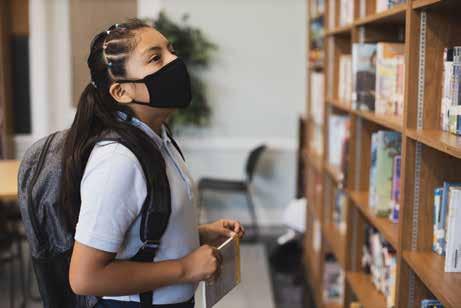
Whatever the Future Holds, There is a Plan
BY SHARON CIVITELLO

Community Support
What will going back to school look like? Will young students keep a mask on all day if required? Will they stay six feet apart? Holy Family School Principal Katie Puthoff and school nurse Jessica Grover agree it can work if expectations are clear and behavior is modeled by adults. “Kids are resilient,” said Puthoff. “They never fail to rise to our expectations.”
One thing is certain: leadership has been busy planning for a safe, effective and welcoming learning environment for 2,300 students enrolled in the 10 parish schools supported by CISE (Catholic Inner-city Schools Education Fund). Whatever the future holds, there is a plan.
“For 40 years the Cincinnati community has been supportive of CISE,” said Mabe Rodriguez, executive director. “Once again, the community has stepped up to help us navigate the ‘new normal’ during the COVID pandemic. We have been meeting with CPS (Cincinnati Public School) Superintendent Laura Mitchell, Steve Muething, Chief Quality Officer at Cincinnati Children’s [Hospital], Cincinnati Bell, and LaSoupe. We are excited and grateful to be working with so many willing partners.” between the CISE schools and Cincinnati Children’s Hospital, said, “I’ve been very impressed with CISE and the forethought and planning that has gone into fall preparation. With clear guidelines from the governor and the CDC, we can create our plan and provide resources.”
Remote vs. Face-to-Face Learning
Parents, children, educators and doctors are all in agreement that at least some in-person learning is needed for children’s development and social skills
Distance learning is especially challenging for children in low-income families. Many are single-parent families. Most are in service industries where working from home is not an option. Technology in the home is limited or nonexistent. Older children often care for younger siblings. CISE school principals have been meeting regularly to share best practices and problem solve.
Teachers, students and families learned much from the spring closures. Chromebooks were sent home and teachers received Google Classroom and distance learning training.
“With CISE support, I was able to reach 100 percent of my students in a focused one-hour meeting every day,” said Michelle Frey, second grade teacher at Holy Family. “It was nothing short of miraculous!”
Students were given time to chat live with their friends facilitating both socialization and writing practice. Virtual field trips to the San Diego Zoo and art museum added adventure.

“It gave me a sense of security to be able to check in on them,” said Frey. “I think I needed this connection as much as they did.”
Frey is hopeful. “We look forward to being back with the kids. Every scenario is being considered” she said. “I’ll do what it takes. We have the virtual thing down. This summer, I’ve taken online classes to be even better prepared. Nothing is being ruled out…even if I have to give lessons on their front porch!”
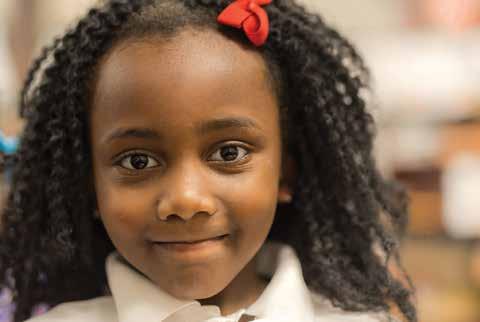
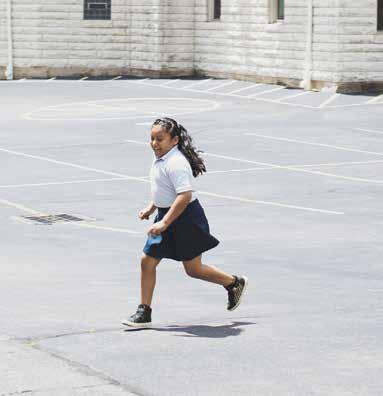
The New Normal
Going forward, schools need to imagine a new normal. In a recent meeting with Muething and four team members from Cincinnati Children’s Hospital, CISE educators learned what that would look like. The top priorities for a safer environment are distancing, masking, hand hygiene and cleaning. They discussed practical and fun ways to implement these critical safety measures. “You have given us a lot to consider,” said Jennifer O’Brien, St. William principal. “The presentation made it easier to think about our reopening plan.”
We will come out better on the other side,” said Puthoff. “Google Classroom has opened up big opportunities. Children will be in different places academically depending on their distance learning experience. We will meet each child where they are.”
Lauren Clements, principal at Corryville Catholic, said, “Kids want to be in school and are willing to follow the rules to make it happen.” Some schools are researching live-stream technology to bring class into the home if a child is not able to attend for health reasons. Clements will offer computer classes for parents to help monitor school work.
Principals are prepared. CISE is partnering with Cincinnati Bell to provide internet access for those in need and working to procure personal protective equipment. Compliance will require additional classroom staff and transportation accommodations.
In a year when donations are expected to decrease, expenses will most certainly increase. If you can help, contact Debbie Weitz at dweitz@catholicAOC.org or (513)661-8156 or visit CISEKids.org.
Katie Puthoff
Principal Embraces Sharing the Faith at Culturally Diverse Price Hill School
BY JOHN STEGEMAN
For Katie Puthoff, principal at Holy Family School in the Cincinnati neighborhood of Price Hill, being an educator isn’t just a job. It is as much a ministry as it is the fulfillment of a childhood dream.

“Even from when I was little, my parents would tell you I wanted to play school and teacher,” Puthoff said. “Even in high school and college, my heart would always go back to education, even if I considered other things… I wanted to be able to care in the same way as the teachers I had. I always just had a passion for kids. No matter where I went or what I did, I wanted to help them become better people.”
Puthoff credits this inspiration to the teachers who taught her as she grew up. In fact, nearly her entire education took place in Catholic schools and universities in the Archdiocese of Cincinnati. She attended St. Michael in Sharonville for grade school, Mount Notre Dame for high school, and University of Dayton for both her undergrad and masters work in college. At each step of the way her vocation for teaching became clearer.
A principal now for three years, Puthoff began teaching at Our Lady of Visitation on Cincinnati’s West Side before returning to teach at her alma mater, St. Michael. She became a principal so her impact could reach more students, helping them grow academically and spiritually.
“Catholic education is truly the future of the Church,” she said. “I enjoy helping to raise kids in the Catholic faith and teaching them how great God can be and how to live a life that is not only fulfilling, but can do good in the world.”
At Holy Family School, Puthoff presides over a unique mix of students, most of whom live nearby. The school’s latest fact sheet reports that the 227 students in pre-K through eighth grade are 64 percent Latino, 15 percent African American, 14 percent Caucasian and 7 percent multiracial. Seventyfour percent of the students are Catholic.
“Our schools is very diverse,” Puthoff said. “The population in Price Hill has shifted a lot in the last 10 years. Many of our students come from families that need a little extra support.”
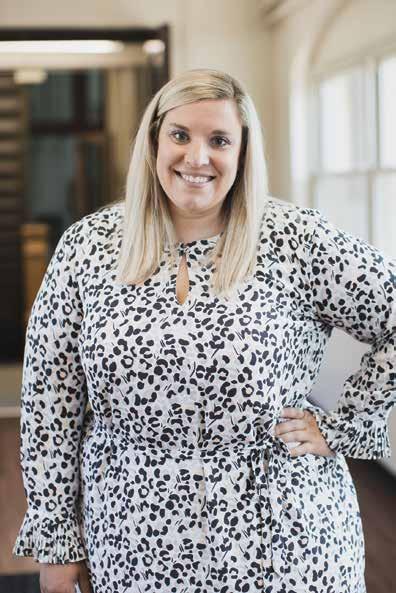
Holy Family is one of nine schools served by the Catholic Inner-City Education Fund (CISE), which provides a broad scope of support, including funding, to the schools.
“I loved teaching at Visitation and St. Michael,” Puthoff said. “But I’ve never seen God work more than in these years I’ve been at Holy Family. God works through people and it’s something I see every day whether it’s a teacher giving their all to help a student or their family, or someone who sends their child here and trusts us to do what’s best for them.”
Coming back to the career aspect, Puthoff emphasized the reasons one should consider following a path to work in Catholic education.
“It is important for people to realize the difference a Catholic education can make in a kid’s life,” Puthoff said. “The biggest thing you should ask yourself is ‘Why do you want to be a Catholic educator and what kind of differences do you want to make?’ If you want to be in a kid’s life and give them opportunities by helping shape their faith and giving them opportunities to learn, then you should consider it.”
SCHOOL OF FAITH Making an Impact in Catholic Schools
BY M.D. PITMAN
Holy Family School of Faith (commonly called School of Faith) expanded into Cincinnati just six years ago, but it is already impacting hundreds of Catholic school administrators, faculty and staff across the Archdiocese of Cincinnati.
Theologians Mike Scherschligt and Troy Hinkel founded School of Faith in 2005, intending to strengthen people’s Catholic faith by sharing the love of Jesus Christ and the Blessed Mother through the New Evangelization. Today, they reach more than 10,000 people every year virtually through podcasts and YouTube, as well as through live events and pilgrimages. John Leyendecker is the Director of Mission with School of Faith Cincinnati, a branch of Holy Family School of Faith in Kansas City, KS. He describes School of Faith as “a movement of family and friends that are trying to draw people closer to Jesus.”
An important prong of their mission is to minister in schools. Leyendecker and Dave Staples, a School of Faith instructor, partner with 23 grade schools and high schools in the archdiocese from as far north as Lehman High School in Shelby County, to schools peppered around Cincinnati’s East and West Sides. Catholic schools and School of Faith partner to form administrators, faculty and staff more deeply in the faith so they can radiate Christ to their students.
An aspect of this work is an annual pilgrimage to the Holy Land designed to facilitate an encounter with the tangible reality of Christ. To-date, more than 180 school personnel have accompanied Leyendecker on pilgrimage.
Vickie Geckle, who teaches at St. Ignatius of Loyola School in Monfort Heights, was on the first pilgrimage in 2015. “In the Holy Land, I encountered Jesus and His Blessed Mother in a much more personal and overwhelming way than I ever had before,” said Geckle. “Ever since, I feel a responsibility and desire to share the experience of Jesus, the sacraments and our whole faith with everyone in my life, especially my students.”
Over the past school year, School of Faith has worked with more than 750 teachers, staff and administrators. Leyendecker said he hopes to add another five to 10 schools over the next few years.
John Leyendecker instructs 2019 School of Faith pilgrims just behind the Church of the Visitation in Ein Karem, Israel.
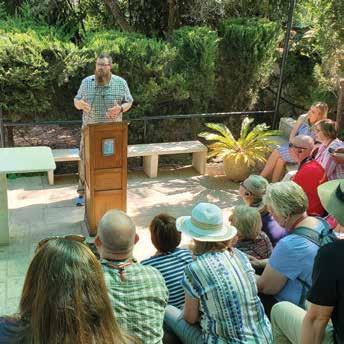
Faith in February 2015 to minister within the Archdiocese of Cincinnati.
“We are living in a culture that is very challenging in many ways; it’s not very accepting of the Catholic faith,” Archbishop Schnurr said in a video about School of Faith receiving the Lumen Vitae Medal from the monks of St. Benedict’s Abbey in Kansas. “The School of Faith is bringing a light into that darkness, and so School of Faith is helping people – starting in our schools – not only know the faith but to witness to the faith.”
The Cincinnati branch of School of Faith has started offering classes and missions in parishes around the archdiocese. A big part of that is praying the Rosary, which is complemented by the School of Faith website, DailyRosary.net. Leyendecker said it provides meditation on the Rosary, offering some aspect, virtue or doctrine of the faith “that’s really broken down in a human way for people to reflect on.”
They also offer “Rosary on the Road,” where people can organize a discussion group in their home, and Leyendecker or Staples will lead the discussion and reflection through fellowship and conversation.
“It’s really been powerful,” Leyendecker said. “We have several thousand people all over the world praying this [online] daily Rosary with us, and starting these kinds of groups where they’re tying people together to have good conversation and friendship.”
“That’s at the root of the Gospel,” he said. “People have to get back to sharing their lives together and focus on Jesus, and consider what the Church has to say. You can trust this 2,000- year old treasure trove.”
DePaul Cristo Rey Coach Cornelius Leads Basketball with Faith and Heart
BY M.D. PITMAN
DePaul Cristo Rey has stood out over the past four years as one of the Tri-State’s best-kept basketball secrets. A perennial Final Four participant in the Ohio Christian Schools Athletic Association (OCSAA) post-season tournament, the school of around 300 students from 38 tri-state zip codes, won the OCSAA title after twice being a third-place finisher and once being the tournament’s runner up.
“It was the best thing for the kids,” said head coach Randy Cornelius, who finished his seventh year with the Bruins – the last four leading the program – with a state title.
The final two minutes of the title game against Circleville’s New Hope Christian was arguably the best in his coaching career. After a close game, the DePaul Cristo Rey’s senior, Montez Johnson, hit a three-pointer with 30 seconds left, giving the team a one-point lead. After a couple back and forth stops, junior Martin Igaba sunk the two biggest free throws of the game to put the Bruins up 50-47 with seconds left.
“After that, the celebration began,” Cornelius said. Cornelius said they were lucky to get the title game in as the following
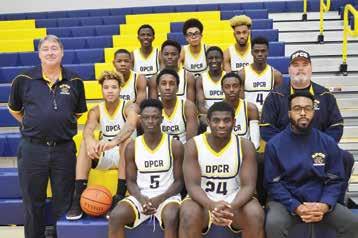
week the Ohio High School Athletic Conference postponed its winter post-season tournament, which was eventually canceled due to COVID-19. And for 2020, DePaul Cristo Rey is the only state high school basketball champion, as the OCSAA is only one division.
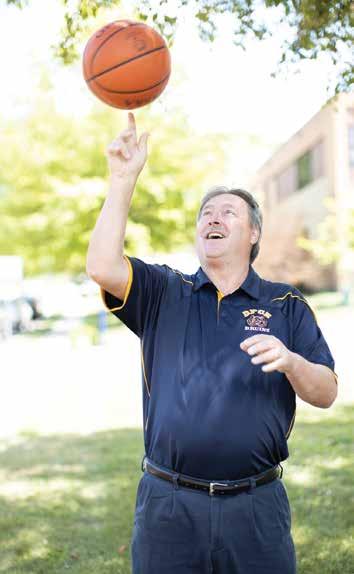

The Bruins’ success in the years leading up to the 2020 title is, in part, because of the basketball strategy and game planning by Coach Cornelius and his assistant coaches, Jeff Birkofer and Casey Troutman. Only two of his 14 players are over sixfeet-tall, but all played significant time on the court. During the season, most games saw 12 to 13 players get into the game before half-time, when most teams only played six or seven.
“We’re not the tallest, but we’re the toughest,” Coach Cornelius said.
While skill and strategy have been staples for the Bruins, so is their faith. The Catholic high school in Clifton was founded in 2011 by the Sisters of Charity. Prayer is a consistent presence in the program, before games and before or after practices.
The team follows a “next man up” mantra, a sports philosophy that anyone on the team can and will be called upon to help the team succeed.
Next year, Coach Cornelious said the team will lose five seniors to graduation. However, with the depth DePaul Cristo Rey has developed leading into the 2020-21 season, the coach said the team’s mantra is “next season up.”




